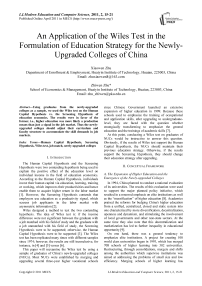An Application of the Wiles Test in the Formulation of Education Strategy for the Newly-Upgraded Colleges of China
Автор: Xiaowen Zhu, Zhiwen Zhu
Журнал: International Journal of Modern Education and Computer Science (IJMECS) @ijmecs
Статья в выпуске: 2 vol.3, 2011 года.
Бесплатный доступ
Using graduates from the newly-upgraded colleges as a sample, we used the Wiles test on the Human Capital Hypothesis vs. the Screening Hypothesis of education economics. The results were in favor of the former, i.e., higher education was more likely a production means than just a signal in the job market. Thus the newly-upgraded colleges should adjust their curriculum and faculty structure to accommodate the skill demands in job markets.
Human Capital Hypothesis, Screening Hypothesis, Wiles test, job match, newly-upgraded colleges
Короткий адрес: https://sciup.org/15010068
IDR: 15010068
Список литературы An Application of the Wiles Test in the Formulation of Education Strategy for the Newly-Upgraded Colleges of China
- G. Becker, Human Capital, New York: Columbia University Press, 1964.
- M. Spence, “Job market signaling,” The Quarterly Journal of Economics, vol. 87, no. 3, pp. 355–374, August, 1973.
- P. Wiles, “The correlation between education and earnings: the External-Test-Not-Content hypothesis,” Higher Education, vol. 3, no. 1, pp. 43–58, 1974.
- G. Arabsheibani, “The Wiles test revisited,” Economics Letters, vol. 29, pp. 361–364, 1989.
- W. N. Grubb, “The returns to education in the sub-baccalaureate labor market,” Economics of Education Review, vol. 16, no. 3, pp. 231–245, 1997.
- P. W. Miller and P. A. Volker, “The screening hypothesis: an application of the Wiles test,” Economic Inquiry, vol. 22, pp. 121–127, 1984.
- W. H. Xie, “Match and adaption – the two patterns of relationship between trainings in higher education and the labor market,” Peking University Education Review, no. 4, pp. 9–11, 2004.
- R. Yang, "Chapter 8. toward massification: higher education development in the People's Republic of China since 1949," in Higher Education: Handbook of Theory and Research, Vol. XIX, J. C. Smart, Eds. 2004, pp. 311–374.
- K. Ngok and M. H. Lee, "Localization of higher education and its social consequences in mainland China,1993-2006," unpublished.
- J. Zhou, Higher Education in China, Florence, KY: Cengage Learning, 2005.
- UNESCO, World Higher Education Report, 2003.
- China Education Online, “The 2010 enrollment plan of Pe-king University,” http://gkcx.eol.cn/schoolhtm/schoolPlan/5703/schoolPlan5703.htm, retrieved on 2010-8-1.
- Bulletin of Ministry of Education of the People's Republic of China, no. 92, 2010, http://www.moe.edu.cn/edoas/website18/level3.jsp?tablename=1263440017913682&infoid=1275547140496537, retrieved on 2010-8-2.
- J. Xiao, "China’s educational reform in transition: is it transforming?" Chinese University of Hong Kong, unpublished, 2007.
- Z. P. Li and W. D. Wu, “The characteristics and modes of the newly-upgraded colleges’ upgrading to undergraduate-level in essence”. Higher Education Research of China, no. 6, pp. 39-41, 2005.
- E. Richards, “Early employment situations and work role satisfaction among recent college graduates,” Journal of Vocational Behavior, vol. 24, pp. 305–318, 1984.
- A. Biglan, “The characteristics of subject matter in different academic areas,” Journal of Applied Psychology, vol. 57, no. 3, pp. 195–203, 1973.
- M. Rosenberg, Society and the Adolescent Self-image. Princeton, NJ: Princeton University Press, 1965.
- J. Heckman, “Sample selection bias as a specification error,” Econometrica, vol. 47, pp. 153–161, 1979.


